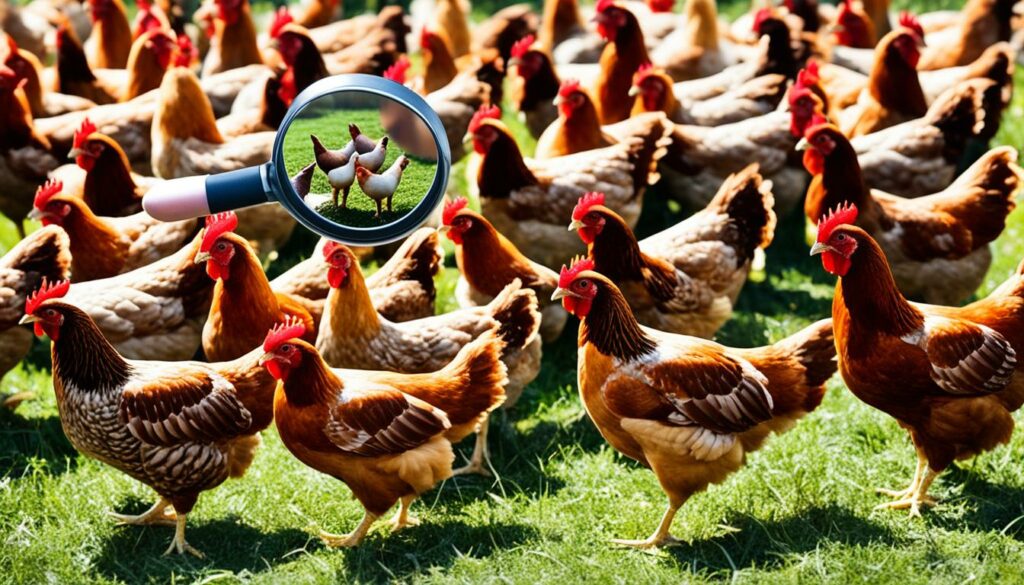Originally posted on December 24, 2023 @ 3:09 am
Welcome to our informative article on grocery store eggs. Have you ever wondered if the eggs you buy from the grocery store are fertilized? In this article, we will explore the fascinating world of egg production, farming practices, and the fertilization process. Let’s dive in and find out the truth about grocery store eggs!
Table of Contents
Key Takeaways:
- Most eggs sold commercially in grocery stores have not been fertilized.
- Egg production facilities in grocery stores do not have roosters, which are necessary for fertilization.
- While it is possible to hatch chicks from fertilized eggs, it is not common with grocery store eggs.
- Egg quality and appearance are graded based on standards and do not indicate whether the eggs are fertilized or not.
- Fertilized eggs are safe to eat and have no nutritional differences compared to non-fertilized eggs.
Understanding Egg Production and Farming Practices

In grocery store egg production facilities, roosters are not present. As a result, the eggs available are not fertilized. This is because the focus of these facilities is on producing eggs from egg-laying hens, and roosters are not required for this purpose.
Egg labeling in grocery stores often includes terms such as “organic,” “free-range,” and “cage-free.” These labels pertain to the farming practices and living conditions of the hens, not whether the eggs are fertilized or not. It’s important to note that the absence of roosters in these facilities ensures that the majority of eggs sold in grocery stores are not fertilized.
Hatching Eggs from Grocery Stores?

While it is generally not possible to hatch a chick from an egg purchased from a grocery store, there have been rare instances where individuals have successfully hatched chicks from fertilized eggs bought at certain grocery stores. These fertilized eggs are usually labeled as such, indicating that a rooster was present during the egg-laying process. However, it is important to note that this is not a common occurrence and most eggs sold in grocery stores are non-fertilized.
Successful Hatching from Grocery Store Eggs: The Exception, Not the Rule
Although it may seem surprising, some grocery store eggs have the potential to hatch into adorable chicks. However, it’s crucial to understand that these cases are extremely rare. The vast majority of eggs found in grocery stores are not fertilized and cannot be hatched. Only a select few eggs explicitly labeled as “fertilized” contain the necessary genetic material to develop into a living being.
In most commercial egg production facilities, including those that supply grocery stores, roosters are not present. This absence is because the focus is primarily on egg-laying hens rather than breeding. Without roosters, the eggs produced by these hens are non-fertilized and cannot give rise to chicks.
While grocery stores generally do not specialize in selling fertilized eggs, there have been rare instances where customers were pleasantly surprised by a successful hatch. These exceptional cases most likely occur when the eggs are sourced from smaller-scale farms that do maintain roosters alongside the hens. In these unique circumstances, the eggs become fertilized, providing the possibility of hatching.
It’s important to mention that successfully hatching chicks from grocery store eggs is not something to be relied upon or expected. The chances of purchasing a fertilized egg from a typical grocery store are incredibly low. So while the thought of hatching a chick from a store-bought egg may be intriguing, it is best to explore alternative avenues, such as reputable hatcheries or local farmers, for guaranteed fertile eggs.
Table 3: Fertilized Eggs in Grocery Stores – Rarity and Expectations
| Scenario | Likelihood |
|---|---|
| Eggs sold in typical grocery stores | Very unlikely to be fertilized |
| Eggs labeled as “fertilized” or sourced from small-scale farms | Possibility of fertilization, but still rare |
As the table illustrates, the chances of finding fertilized eggs in a standard grocery store are exceedingly low. While it may be tempting to try hatching eggs from your local grocery store, it’s important to remember that most eggs sold in these establishments are not intended for hatching. If you’re looking to embark on the rewarding experience of hatching chicks, it’s advisable to explore alternative options, such as direct purchase from breeders or specialized hatcheries.
A Viral TikTok Experiment

A TikTok video recently went viral, capturing the attention of viewers worldwide. In the video, a user documented their successful attempt at hatching chicks from fertilized eggs purchased at a local grocery store. This unexpected outcome sparked a wave of interest and curiosity surrounding the possibility of hatching eggs from grocery stores.
However, it is important to note that this TikTok experiment represents an isolated incident rather than the norm. While the video may have generated excitement and wonder, it is crucial to understand that most eggs available at grocery stores are not fertilized.
Although the viral TikTok video showcased a unique occurrence, it is essential to remember that commercial egg production typically focuses on egg-laying hens without the presence of roosters. As a result, the majority of eggs in grocery stores are not capable of hatching chicks.
This TikTok experiment serves as a captivating example of the wonders of nature and the potential surprises that can arise. While it may be a rare occurrence, the video highlights the diverse and intriguing aspects of our food system.
In the next section, we will explore the grading and quality of eggs available in grocery stores, shedding light on the factors that determine their classification and appearance.
Egg Quality and Appearance

Eggs sold in grocery stores undergo a grading process that evaluates their quality and appearance. This grading system helps ensure that consumers receive eggs that meet specific standards. The two primary grades for eggs in the United States are Grade A and Grade AA, each indicating a different level of quality and appearance.
Grade AA Eggs
Grade AA eggs are the highest quality eggs available. These eggs have thick, firm whites and exhibit high, round yolks. The whites of Grade AA eggs are noticeably robust and do not spread much. This grade is preferred for dishes where the appearance of the egg is essential, such as poached or fried eggs. The Grade AA eggs also denote freshness and maintain their quality for a more extended period.
Grade A Eggs
Grade A eggs are also of good quality and have reasonably firm whites. While the whites of Grade A eggs may spread a bit more than those of Grade AA eggs, they are still suitable for most culinary applications. These eggs are often used for baking, scrambling, and hard-boiling. Grade A eggs are a popular choice due to their quality and versatility in various recipes.
It’s important to note that the grading process solely focuses on the physical characteristics of the egg, such as the thickness of the whites and the shape of the yolks. It does not indicate whether the egg is fertilized or not. The grading system is designed to provide consumers with information about the overall quality and appearance of the eggs they purchase.
| Grade | White Thickness | Yolk Appearance |
|---|---|---|
| Grade AA | Thick, firm | High, round |
| Grade A | Reasonably firm | Wide, moderately high |
Table: Egg Grades and Characteristics
Understanding the grading system allows consumers to make informed choices when purchasing eggs and selecting the most suitable grade based on their intended use. Whether you prefer Grade AA eggs for their appearance or Grade A eggs for their versatility, both grades meet the standards set for quality eggs in grocery stores.
Enjoy High-Quality Eggs
“Choose eggs that meet your preferences. Whether it’s an impressive appearance or an all-purpose option, both Grade AA and Grade A eggs deliver quality.”
When selecting eggs for your cooking and baking needs, remember that grading is only one aspect to consider. Other factors such as freshness, organic or free-range options, and personal dietary preferences may also influence your choice. By understanding the grading system and exploring different egg options, you can enjoy delicious meals and baked goods with confidence.
Nutrition and Safety of Fertilized Eggs

When it comes to the nutritional value and safety of eggs, there is no significant difference between fertilized eggs and infertile eggs. Both types of eggs provide similar amounts of essential nutrients, including proteins, vitamins, and minerals.
Fertilized eggs are safe to eat, just like non-fertilized eggs. The fertilization process does not impact the safety or quality of the egg. However, it is important to note that fertilized eggs purchased from grocery stores are unlikely to develop into baby chicks. The refrigeration and storage conditions prevent the eggs from being viable for hatching.
There may be instances where you come across blood spots or meat spots in eggs. These spots are not indicative of the eggs being fertilized or containing baby chicks. They are typically caused by natural occurrences during the egg formation process and do not affect the nutritional value, safety, or quality of the egg.
“The safety and nutritional value of fertilized eggs are on par with non-fertilized eggs. Blood spots or meat spots found in eggs are natural and do not indicate fertilization or affect the quality.”
In summary, both fertilized and infertile eggs are equally nutritious and safe to consume. The presence of blood spots or meat spots in eggs does not indicate fertilization, and these occurrences do not impact the quality or safety of the egg.
The Importance of Researching Egg Sources

When it comes to purchasing eggs, consumers have the power to make informed choices by researching and understanding the sources and farming practices involved. This knowledge allows individuals to support the egg industry practices that align with their values while ensuring that the eggs they buy meet their expectations.
By conducting research, consumers can gain insights into the farming practices used in egg production. They can learn about the living conditions of the hens, such as whether they are raised in cages or have access to outdoor spaces. Understanding these practices provides valuable information on animal welfare and allows consumers to support more ethical and sustainable practices in the industry.
Additionally, researching egg sources allows consumers to make choices based on factors such as organic production methods, the use of hormones or antibiotics, and the quality of feed provided to the hens. Some individuals may prefer eggs from chickens that are raised on organic feed without the use of antibiotics or hormones, while others may prioritize eggs from hens that are free-range or have access to outdoor spaces.
Researching egg sources can also help consumers identify local or independent farmers who prioritize sustainable and eco-friendly farming practices. This can be beneficial for individuals who prefer to support small-scale farms or are concerned about the environmental impact of conventional egg production.
Ultimately, conducting research on egg sources empowers consumers to be more conscious of their purchasing decisions and support practices that align with their values. By understanding where their eggs come from and the farming practices involved, individuals can play an active role in shaping the egg industry towards more sustainable, ethical, and humane practices.
Benefits of Researching Egg Sources:
- Supports ethical and sustainable egg production practices.
- Allows consumers to make choices based on animal welfare considerations.
- Provides information on the quality and safety of eggs.
- Helps identify local or independent farmers who prioritize eco-friendly practices.
- Allows consumers to support practices that align with their values.
“Researching egg sources empowers consumers to make conscious purchasing decisions and support more sustainable, ethical, and humane practices in the egg industry.”
Comparison of Different Egg Sources
| Egg Source | Farming Practices | Animal Welfare | Egg Quality | Environmental Impact |
|---|---|---|---|---|
| Conventional Eggs | Factory farming, caged hens | Lower standards | Varies | Higher environmental impact |
| Organic Eggs | Organic feed, no antibiotics or hormones, cage-free hens | Higher standards, access to outdoor spaces | Similar to conventional | Lower environmental impact |
| Free-range Eggs | Natural foraging environment, outdoor access | Higher standards, access to outdoor spaces | Similar to conventional | Lower environmental impact |
| Pasture-raised Eggs | Chickens raised on pasture, natural foraging | Higher standards, access to outdoor spaces | Richer flavor, darker yolk | Lower environmental impact |
Researching egg sources helps consumers understand the differences in farming practices, animal welfare, egg quality, and environmental impact among different egg sources. This knowledge allows individuals to make conscious choices that align with their values, ensuring a more sustainable and ethical egg industry.
Egg Options and Their Meanings

When browsing the egg section at your local grocery store, you may come across various options, each with its own label and meaning. Understanding these different egg options can help you make informed choices based on your preferences and values. Let’s take a closer look at some of the most common egg options available:
Organic Eggs
Organic eggs are produced by hens raised on organic feed without the use of antibiotics or hormones. These hens have access to outdoor spaces where they can engage in natural behaviors, such as scratching and pecking. Organic egg production focuses on sustainability and the well-being of the hens, offering consumers a choice that aligns with their desire for organic and natural food products.
Free-Range Eggs
Free-range eggs are laid by hens that have access to outdoor spaces. These hens can roam, forage, and engage in natural behaviors, resulting in a more enriched and fulfilling environment. Free-range egg production allows hens to experience a closer connection to nature, providing consumers with the option to support farming practices that prioritize animal welfare and freedom of movement.
Pasteurized Eggs
Pasteurization is a process that kills any potential bacteria present in the egg, enhancing its safety and shelf life. Pasteurized eggs undergo heat treatment while still maintaining the nutritional integrity and taste of the egg. This option is particularly beneficial for individuals with weakened immune systems, pregnant women, or those who prefer added assurance when consuming raw or undercooked eggs. Pasteurized eggs offer a safe alternative without compromising taste or quality.
By understanding these different egg options, you can choose eggs that best align with your preferences and values. Whether you opt for organic, free-range, or pasteurized eggs, each option provides a unique set of benefits. Let’s explore these options further in the table below:
| Egg Option | Description |
|---|---|
| Organic Eggs | Eggs from hens raised on organic feed without antibiotics or hormones. |
| Free-Range Eggs | Eggs laid by hens with access to outdoor spaces for natural behaviors. |
| Pasteurized Eggs | Eggs that undergo heat treatment to kill bacteria while maintaining nutritional integrity. |
Incorporating these different egg options into your diet allows you to support various farming practices and enjoy eggs that cater to your specific needs. Experiment with different options and discover the unique flavors and benefits each one offers.
Now that you are familiar with the different egg options available, you can confidently select the eggs that best suit your lifestyle and preferences. Explore your local grocery store’s egg selection and make the choice that aligns with your values and dietary needs.
Factors Affecting Egg Prices
The cost of eggs can vary based on several factors. One of the main factors influencing egg prices is the cost of feed. Specialty feeds, such as organic and high omega-3 content feed, are generally more expensive than conventional feed. These feeds are formulated to provide specific nutritional benefits and cater to consumer preferences for healthier options.
Additionally, another factor that can impact the price of eggs is the space requirements of the hens laying the eggs. Eggs from hens that require more space, such as cage-free and free-range hens, tend to be costlier. This is because providing adequate space for the hens to move around freely increases the production costs for the farms, translating to higher prices for the eggs.
To give you a better understanding, here’s a breakdown of the main factors affecting egg prices:
| Factor | Explanation |
|---|---|
| Feed Costs | The type of feed provided to the hens, including organic and specialty feeds, can impact the overall cost of producing eggs. |
| Space Requirements | Egg production systems that prioritize providing more space for hens, such as cage-free and free-range systems, require additional investment and maintenance costs. |
These factors contribute to the variations in egg prices you may encounter when shopping for eggs. It’s important to consider your budget, values, and preferences when making a purchase decision. Understanding the factors behind the pricing can help you make an informed choice that aligns with your needs and priorities.
Conclusion
In conclusion, when it comes to grocery store eggs, the majority of them are not fertilized. This is because the focus of commercial egg production is on egg-laying hens, and roosters are not necessary for this purpose. The eggs you find in the grocery store are typically sourced from poultry farms where there are no roosters present.
While it is rare, there have been instances where people have successfully hatched chicks from fertilized eggs purchased at certain grocery stores. However, it’s important to note that this is not the norm. The eggs that are sold in grocery stores are typically non-fertilized.
As a consumer, it’s important to be aware of the farming practices and research where your eggs come from. Understanding the processes behind egg production can help you make informed choices. Whether you prefer fertilized or non-fertilized eggs, knowing the source of your eggs ensures that you are supporting practices that align with your values and expectations.
FAQ
Are grocery store eggs fertilized?
No, most eggs sold in grocery stores are not fertilized. Commercial egg production facilities do not have roosters present, and eggs are usually sourced from poultry farms where the focus is on egg-laying hens and not fertilization.
Do grocery store egg labels indicate if the eggs are fertilized or not?
No, egg labeling in grocery stores typically includes terms like organic, free-range, and cage-free, which pertain to farming practices and living conditions of the hens. It does not indicate whether the eggs are fertilized or not.
Can you hatch chicks from eggs purchased at grocery stores?
While it is generally not possible to hatch chicks from eggs bought at grocery stores, there have been rare instances where individuals have successfully hatched chicks from fertilized eggs labeled as such. However, this is not a common occurrence.
Did a viral TikTok video show someone hatching chicks from grocery store eggs?
Yes, a viral TikTok video gained attention by showing a user successfully hatching chicks from fertilized eggs purchased at a grocery store. However, these instances are not the norm, and most grocery store eggs are not fertilized.
How are eggs graded based on quality and appearance?
Eggs are graded into different categories based on their quality and appearance. Grade AA eggs have thick, firm whites and high, round yolks, while Grade A eggs have reasonably firm whites. Grade B eggs have thin whites and wider yolks.
Is there a nutritional difference between fertilized and unfertilized eggs?
No, there is no nutritional difference between fertilized and unfertilized eggs. Both types of eggs are safe to eat and provide the same nutritional value.
Why is researching egg sources and farming practices important?
Researching egg sources and farming practices allows consumers to make informed choices about the conditions in which the hens are raised and the production methods used. It empowers consumers to support practices that align with their values.
What do terms like organic, free-range, and pasteurized mean for eggs?
Organic eggs come from hens raised on organic feed without the use of antibiotics or hormones. Free-range eggs are laid by hens that have access to outdoor spaces. Pasteurized eggs go through a process that kills any potential bacteria while maintaining the egg’s nutritional integrity.
What factors affect the price of eggs?
The cost of eggs can vary based on factors like the cost of feed. Organic and high omega-3 content feed can be more expensive than conventional feed. Eggs from hens that require more space, such as cage-free and free-range hens, can also be costlier due to additional space requirements and associated costs.
Is there a difference in grocery store eggs being fertilized or not?
No, the majority of eggs sold in grocery stores are not fertilized. While rare instances of fertilized eggs being available for purchase have occurred, it is not the norm for grocery store eggs.
Source Links
- https://www.canr.msu.edu/news/can_you_hatch_an_egg_bought_from_the_store
- https://www.dailydot.com/news/fertile-eggs-trader-joes/
- https://agclassroom.org/hatching/buying/
See also:
Leave a Reply